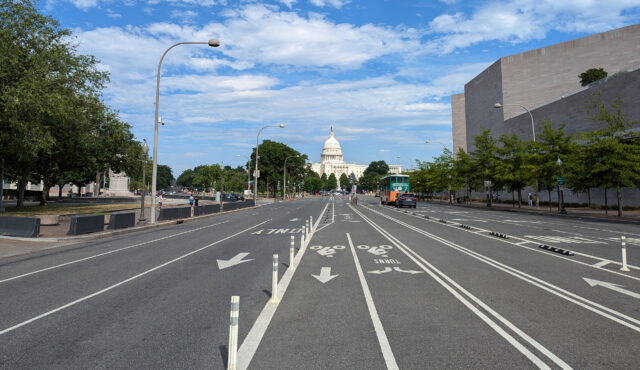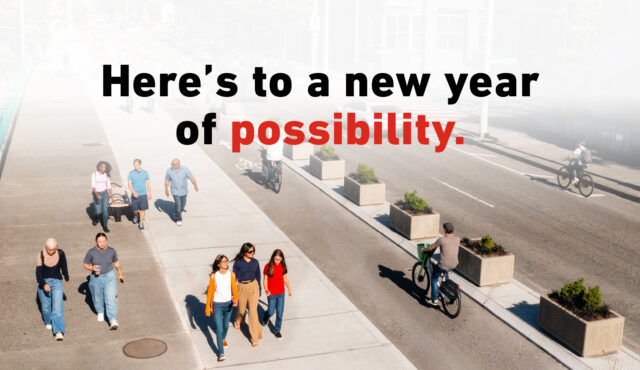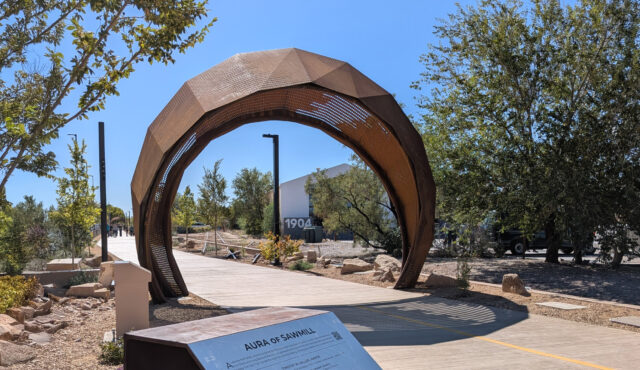As we head toward this year’s application deadline for the Safe Streets and Roads for All (SS4A) grants program on July 10, many cities and regions are hoping to win an Implementation Grant to fund the design and construction of some of the projects identified in their Safety Action Plans. If you’re at that point, your Safety Action Plan should identify improvements that address the greatest need and have the highest impact on improving safety for all road users, including people walking, biking, taking transit, and using mobility devices. But perhaps the step toward implementation feels like a leap…
Where do you start? How do you effectively move from a Safety Action Plan into the implementation phase?
Toole Design suggests developing a detailed plan that follows the SS4A Safety Action Plan Components through a robust crash analysis, thoughtful community engagement, and meaningful collaboration across departments and agencies to develop a comprehensive list of projects and actions. Every action plan should lay out a clear and measurable path to preventing fatal and serious injuries through the lens of the Safe System Approach principles and framework to create a positive roadway safety culture.
For more than a decade, Toole Design has supported cities throughout North America in the development of Safety Action Plans and helped turn those plans into action. Our safety approach rests upon these two pillars:
- Prioritize the most vulnerable road users first, always. We know that road users outside of a vehicle are at greater risk for fatal and serious injury in the event of a crash. Thus, we must do more to protect people walking, bicycling, and rolling. Whether we are performing a technical crash analysis early on in a project or making choices about where to start with implementation, we prioritize vulnerable road user safety. Through the Safe System Approach framework, for example, we must separate users in space so that if a crash occurs it cannot result in a fatal or serious injury for the road user most at risk of injury. We prioritize slowing cars down, and we deprioritize traffic congestion or level of service measures. We also prioritize projects in underserved areas, since the crash risk is often higher for people traveling in these areas.
- Get agency- and community-wide buy-in for the ultimate goal of ZERO. Vision Zero initiatives require setting a clear target and committing to reaching that target through collaboration and shared responsibility. At every step, strong partnerships are essential (more on this below!). We have found the most success when identified partners can clearly articulate their role and how it contributes to the larger goal. Eliminating roadway deaths and serious injuries takes coordination and connectivity, so everyone needs to be on the same page for a holistic effort; it’s not just the responsibility of public works, the police, or any single department. Everyone must commit to creating a safe system, together.
This approach is now embodied in the SS4A application process. By keeping the tenets of the Safe System Approach at the center, Toole Design is helping SS4A grant applicants and awardees move from planning to the implementation stage, prioritizing and executing the appropriate countermeasures and campaigns for their communities. Below, we highlight a few cities we’ve worked with — Lancaster, Tacoma, and Boston — to demonstrate three key principles for parlaying a Safety Action Plan into a successful implementation:

Build Partnerships from the Beginning

Place equity at the center

take a holistic approach
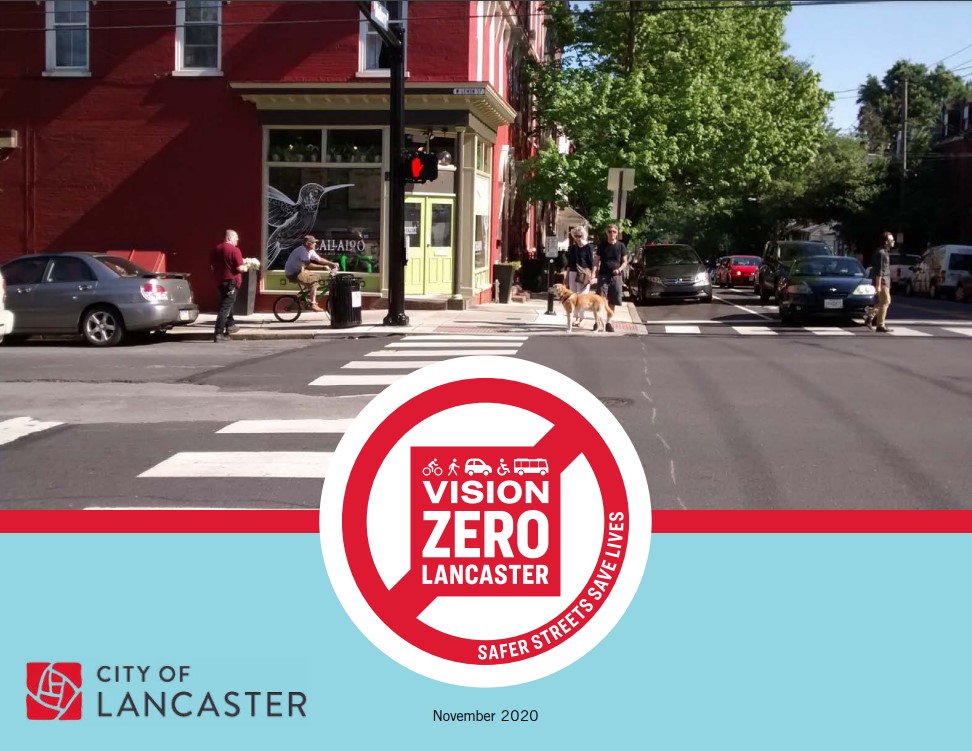 Achieving Vision Zero, like any major community effort, is as much about relationships as it is about projects. To create the Lancaster Vision Zero Action Plan, published in 2020, we worked with the City of Lancaster to identify not only the projects and programs to be implemented, but also the partnerships that would make that implementation possible. The City’s close relationships with partners were essential from the start, making it feasible for us to engage with residents and stakeholders in creative ways as the pandemic set in.
Achieving Vision Zero, like any major community effort, is as much about relationships as it is about projects. To create the Lancaster Vision Zero Action Plan, published in 2020, we worked with the City of Lancaster to identify not only the projects and programs to be implemented, but also the partnerships that would make that implementation possible. The City’s close relationships with partners were essential from the start, making it feasible for us to engage with residents and stakeholders in creative ways as the pandemic set in.
This collaborative spirit comes through in the Action Plan, which identifies City-led projects as well as items to be led by PennDOT, Lancaster General Hospital, Lancaster School District, and others. Before the ink was dry on the Action Plan, a teacher who was part of the Plan’s Steering Committee had already delivered a Vision Zero curriculum to her classroom!
With crash data from PennDOT, we identified locations with higher crash rates, locations with more serious crashes, and populations that suffer disproportionately in crashes (such as people riding bikes and walking). As a result, the final Action Plan includes prioritized projects where the safety risk is highest. This is helping the City to confidently take actions that will have the greatest safety impact.
Since the publication of the Action Plan, we have continued to support the City of Lancaster through an implementation-focused on-call contract to bring the Action Plan to life. So far, this work has included the development of a detailed year-by-year work plan including the production of concept designs and cost estimates for high-priority locations. We also worked with the City to develop a Vision Zero education campaign and toolkit. And we supported the City in securing a $12 million SS4A grant to help fund the Plan’s implementation.
There is much work to be done, but the City of Lancaster and its partners are on their way to achieving their goal of zero traffic deaths and serious injuries by 2030.
2. Place Equity at the Center | Tacoma, WA
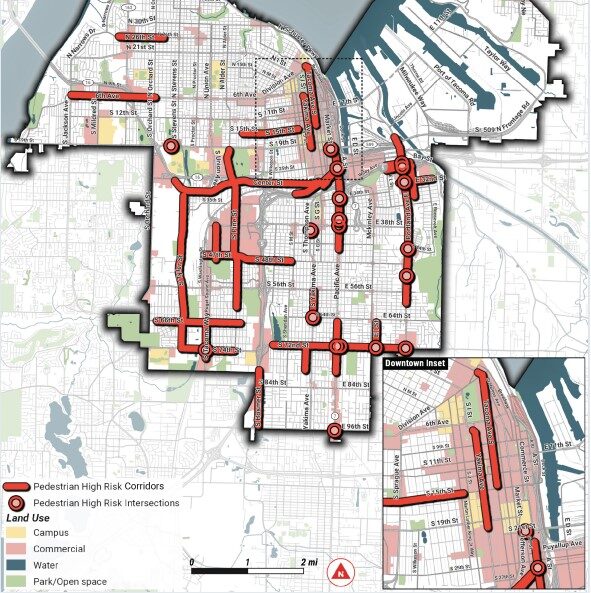
Equity is more than a buzzword in safety planning — it is at the heart of the Safe System framework’s emphasis on safety for all. The Tacoma Vision Zero Action Plan, the ITE Washington Chapter’s 2022 Planning Project of the Year, is an example of an equity-focused process that is leading to equity-focused solutions.
To identify clear and tangible actions for meeting the City’s Vision Zero goals, we worked with a stakeholder advisory group comprised of Tacoma community members representing diverse communities. The Plan’s recommendations reflect that community input. For example, the Plan deprioritizes enforcement and focuses instead on building and supporting systems that contribute to road safety in Tacoma, including “self-enforcing” street design and supportive policies.
We also provided tools and analysis to make sure the implementation of the Plan would make the most impact where it was most needed, including:
- A High Injury Network, to help City staff identify risks to the most vulnerable users
- An Equity Index, an interactive tool that maps disparities by visually highlighting where residents have more or less access to opportunity
- A Local Road Safety Plan (LRSP)
- A Safety Countermeasure Toolkit
- A Speed Reduction Guidebook
- A Vision Zero dashboard to allow City staff and the public to track progress toward reducing serious and fatal crashes
Without missing a beat, the City moved from plan into action, starting with reducing speeds on some of its streets. We also immediately began developing concept designs for one of the highest risk corridors identified in the Action Plan.
With principles of inclusion and equity baked into their Action Plan and their overall Vision Zero approach, Tacoma is taking clear, intentional steps to implement a strategy that aligns with the values, needs, and experiences of the community.
3. Take a Holistic Approach | Boston, MA
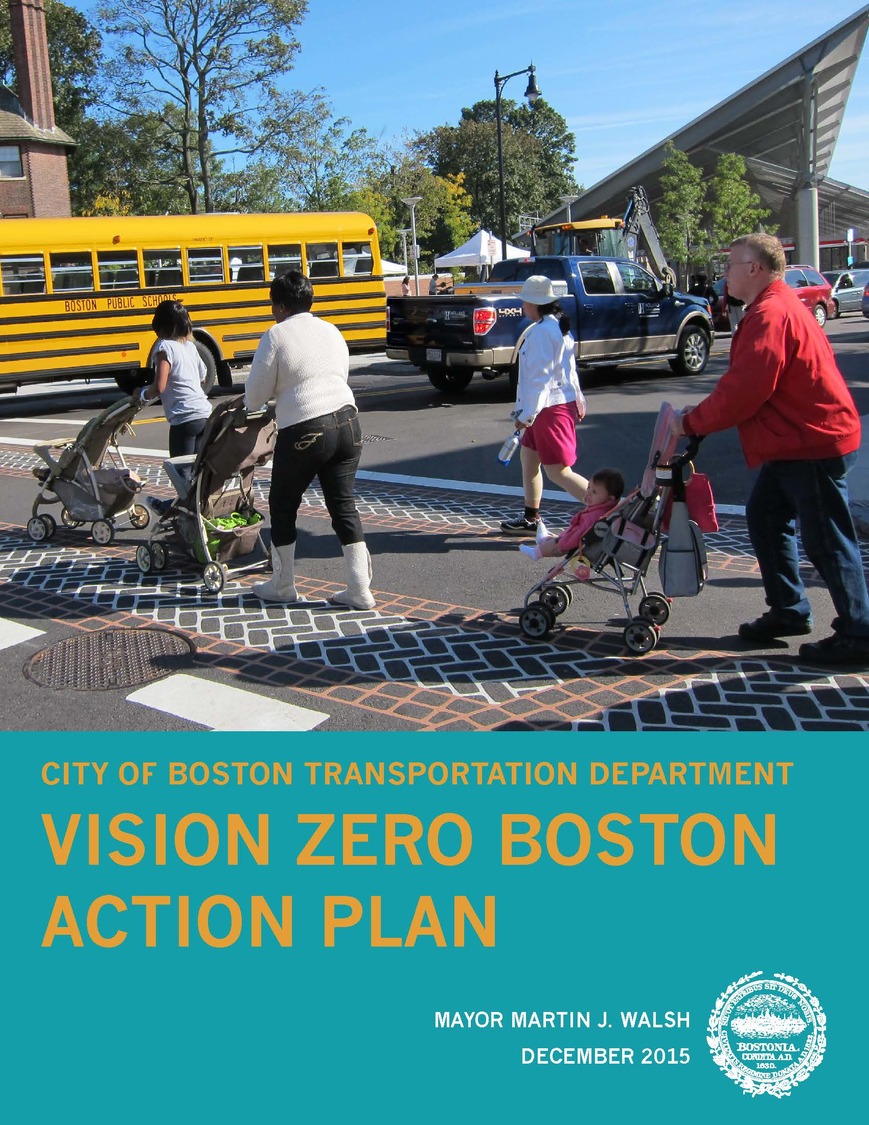 In recent decades, Boston has emerged as a leader in bicycle and pedestrian infrastructure and policy. The City of Boston was among the first in the nation to commit to eliminating fatal and severe traffic crashes using a Vision Zero approach. In 2015, the City adopted Vision Zero and hired Toole Design to assist with the development of their groundbreaking Vision Zero Action Plan. This ushered in an important new phase in tackling traffic safety in a more holistic and systemic way, while still responding in the aftermath of fatal crashes to fix immediate problems.
In recent decades, Boston has emerged as a leader in bicycle and pedestrian infrastructure and policy. The City of Boston was among the first in the nation to commit to eliminating fatal and severe traffic crashes using a Vision Zero approach. In 2015, the City adopted Vision Zero and hired Toole Design to assist with the development of their groundbreaking Vision Zero Action Plan. This ushered in an important new phase in tackling traffic safety in a more holistic and systemic way, while still responding in the aftermath of fatal crashes to fix immediate problems.
Toole Design staff are part of a multidisciplinary, multi-agency Rapid Response Team that studies every fatal crash in the City. At one location on Washington Street in the Roslindale neighborhood, an older adult woman was struck and killed crossing from a bus stop to her apartment. Using the safe crossing toolbox we developed, we quickly implemented a new crossing design that improved sight lines, defined and narrowed travel lanes, and created a tactical crossing island with a Rectangular Rapid Flashing Beacon (RRFB). Those changes resulted in significantly increased yielding rates, a 10–20% vehicle speed reduction, and no injury crashes recorded since installation.
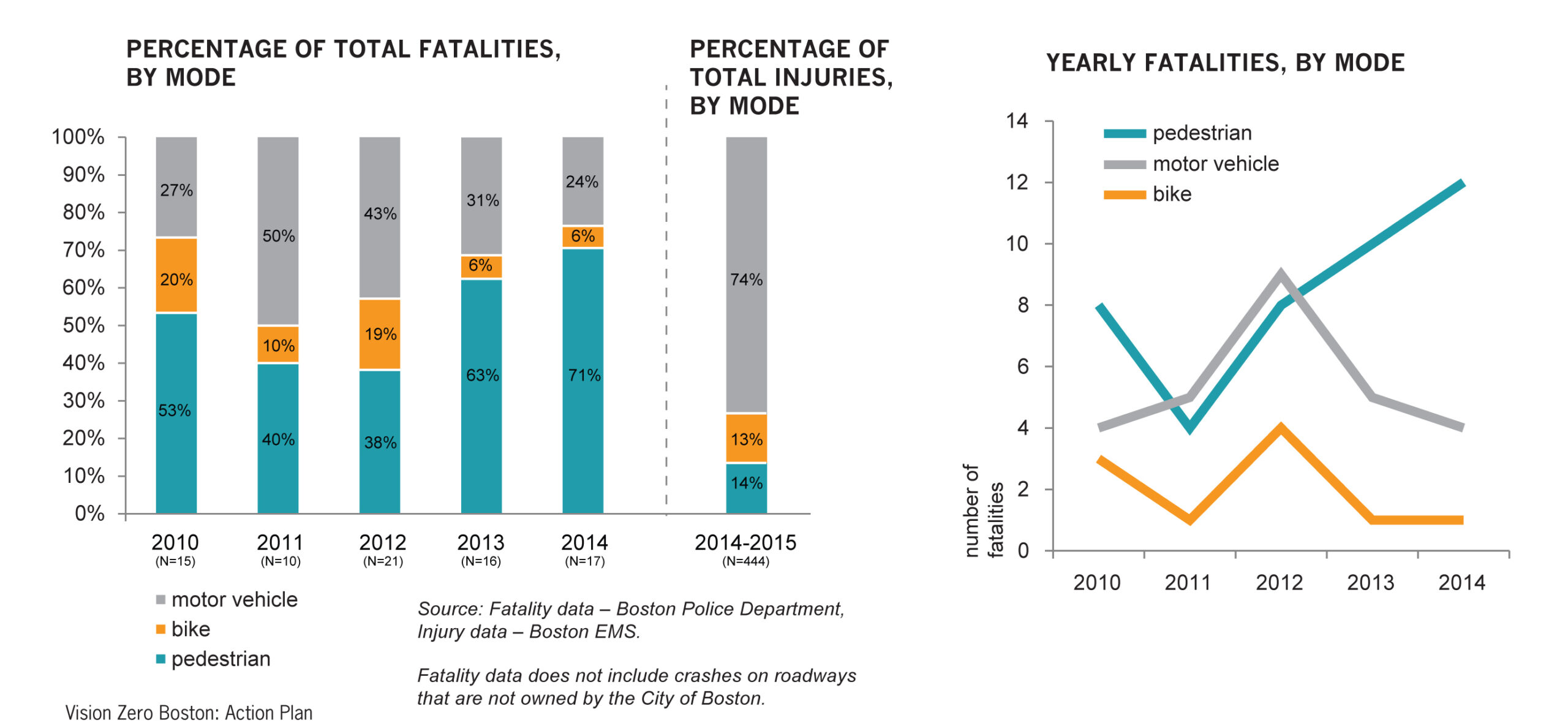
We have also developed preliminary designs and safety recommendations that the City used to acquire State and Federal funding assistance, including SS4A implementation grants. By leveraging outside funding, the City is able to think more broadly about project delivery opportunities, extending the Vision Zero approach to projects beyond the scope of the initial Vision Zero Rapid Response and Rapid Implementation program.
This work with the City of Boston demonstrates how taking a systemic approach works in tandem with individual crash responses. By developing processes and toolkits that can quickly be deployed in the aftermath of a fatal or serious crash, cities can respond quickly and effectively. When we consider crashes in the context of a broader system, we can stop treating them as random-but-inevitable flukes and start taking real measures to prevent them from happening again.
Your Safety Plan in Action
The once-in-a-generation SS4A funding opportunity is a boon to so many cities and towns that are ready to make their roadways safer for all people. Whether you already have a Safety Action Plan in place or you’re just starting your Safe System Approach journey, the principles outlined above can be incorporated to ensure you are setting your community up for safety success.
We are working toward a safer, more equitable transportation future where Vision Zero is a reality, not just an aspiration — and we know we all need to work together to achieve this vision. Please reach out to Toole Design staff at any point for help navigating SS4A and assessing the best approach to safety in your community.
